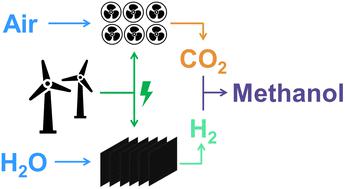当前位置:
X-MOL 学术
›
Energy Environ. Sci.
›
论文详情
Our official English website, www.x-mol.net, welcomes your feedback! (Note: you will need to create a separate account there.)
Managing intermittency of renewable power in sustainable production of methanol, coupled with direct air capture
Energy & Environmental Science ( IF 32.4 ) Pub Date : 2024-06-04 , DOI: 10.1039/d4ee00933a George J. Fulham 1 , Paula V. Mendoza-Moreno 1 , Ewa J. Marek 1
Energy & Environmental Science ( IF 32.4 ) Pub Date : 2024-06-04 , DOI: 10.1039/d4ee00933a George J. Fulham 1 , Paula V. Mendoza-Moreno 1 , Ewa J. Marek 1
Affiliation

|
Coupling direct air capture (DAC) with methanol production is a technically attainable opportunity for CO2 capture and utilisation (CCU). The process, known as power-to-methanol (PtM), consumes large amounts of renewable electricity for water electrolysis and DAC. However, the time-variability of renewable power remains a major challenge. Here, we consider erecting a wind farm as part of a PtM facility and propose using four parallel reactors to adjust the methanol production according to daily wind power generation, which we model for 90 onshore and offshore locations with real-world data. Batteries and reserve storage of compressed H2 and CO2 allow methanol production during near-zero availability of wind power. We investigate different operation strategies, aiming to either minimise the reserve storage or maximise production, ultimately finding minimised storage as more cost-effective. The resulting selling price of methanol from a plant powered by an onshore wind farm is $1400 per tonne, rising to $2200 for offshore wind power because of higher farm installation costs. However, with a well-located wind farm, coupled with improvements to DAC, electrolysis, and catalysts, the selling price falls as low as $300 per tonne of methanol, reaching parity with fossil fuel-derived methanol. Purchasing stable grid power for PtM avoids issues of intermittency, and results in a lower methanol selling price of $960 per tonne, falling to $340 with process improvements. However, life cycle assessment (LCA) shows the global warming potential (GWP) of the grid-based cases is no better than producing methanol from natural gas; whereas, wind-powered DAC-PtM delivers net-negative GWP between −760 and −1240 kgCO2eq. per tMeOH, demonstrating successful CCU.
中文翻译:

管理甲醇可持续生产中可再生能源的间歇性,并结合直接空气捕获
将直接空气捕获 (DAC) 与甲醇生产相结合是 CO 2 捕获和利用 (CCU) 技术上可实现的机会。该过程被称为电力转甲醇 (PtM),消耗大量可再生电力用于水电解和 DAC。然而,可再生能源的时间变化仍然是一个重大挑战。在这里,我们考虑建立一个风电场作为 PtM 设施的一部分,并建议使用四个并联反应器根据每日风力发电量调整甲醇产量,我们使用真实世界数据对 90 个陆上和海上地点进行了建模。电池和压缩 H 2 和 CO 2 的储备存储允许在风电可用性接近于零的情况下生产甲醇。我们研究了不同的运营策略,旨在最小化储备存储或最大化产量,最终发现最小化存储更具成本效益。由此产生的由陆上风电场供电的工厂的甲醇售价为每吨 1400 美元,由于风电场安装成本较高,海上风电的甲醇售价升至每吨 2200 美元。然而,凭借地理位置优越的风电场,再加上 DAC、电解和催化剂的改进,甲醇的售价可低至每吨 300 美元,与化石燃料衍生的甲醇持平。为 PtM 购买稳定的电网电力可以避免间歇性问题,并导致甲醇售价降低至每吨 960 美元,随着工艺改进,甲醇售价降至 340 美元。 然而,生命周期评估(LCA)显示,并网案例的全球变暖潜势(GWP)并不比天然气生产甲醇好;而风力驱动的 DAC-PtM 每吨 MeOH 的净负 GWP 介于 -760 至 -1240 kg CO2eq. 之间,证明了 CCU 的成功。
更新日期:2024-06-04
中文翻译:

管理甲醇可持续生产中可再生能源的间歇性,并结合直接空气捕获
将直接空气捕获 (DAC) 与甲醇生产相结合是 CO 2 捕获和利用 (CCU) 技术上可实现的机会。该过程被称为电力转甲醇 (PtM),消耗大量可再生电力用于水电解和 DAC。然而,可再生能源的时间变化仍然是一个重大挑战。在这里,我们考虑建立一个风电场作为 PtM 设施的一部分,并建议使用四个并联反应器根据每日风力发电量调整甲醇产量,我们使用真实世界数据对 90 个陆上和海上地点进行了建模。电池和压缩 H 2 和 CO 2 的储备存储允许在风电可用性接近于零的情况下生产甲醇。我们研究了不同的运营策略,旨在最小化储备存储或最大化产量,最终发现最小化存储更具成本效益。由此产生的由陆上风电场供电的工厂的甲醇售价为每吨 1400 美元,由于风电场安装成本较高,海上风电的甲醇售价升至每吨 2200 美元。然而,凭借地理位置优越的风电场,再加上 DAC、电解和催化剂的改进,甲醇的售价可低至每吨 300 美元,与化石燃料衍生的甲醇持平。为 PtM 购买稳定的电网电力可以避免间歇性问题,并导致甲醇售价降低至每吨 960 美元,随着工艺改进,甲醇售价降至 340 美元。 然而,生命周期评估(LCA)显示,并网案例的全球变暖潜势(GWP)并不比天然气生产甲醇好;而风力驱动的 DAC-PtM 每吨 MeOH 的净负 GWP 介于 -760 至 -1240 kg CO2eq. 之间,证明了 CCU 的成功。






































 京公网安备 11010802027423号
京公网安备 11010802027423号